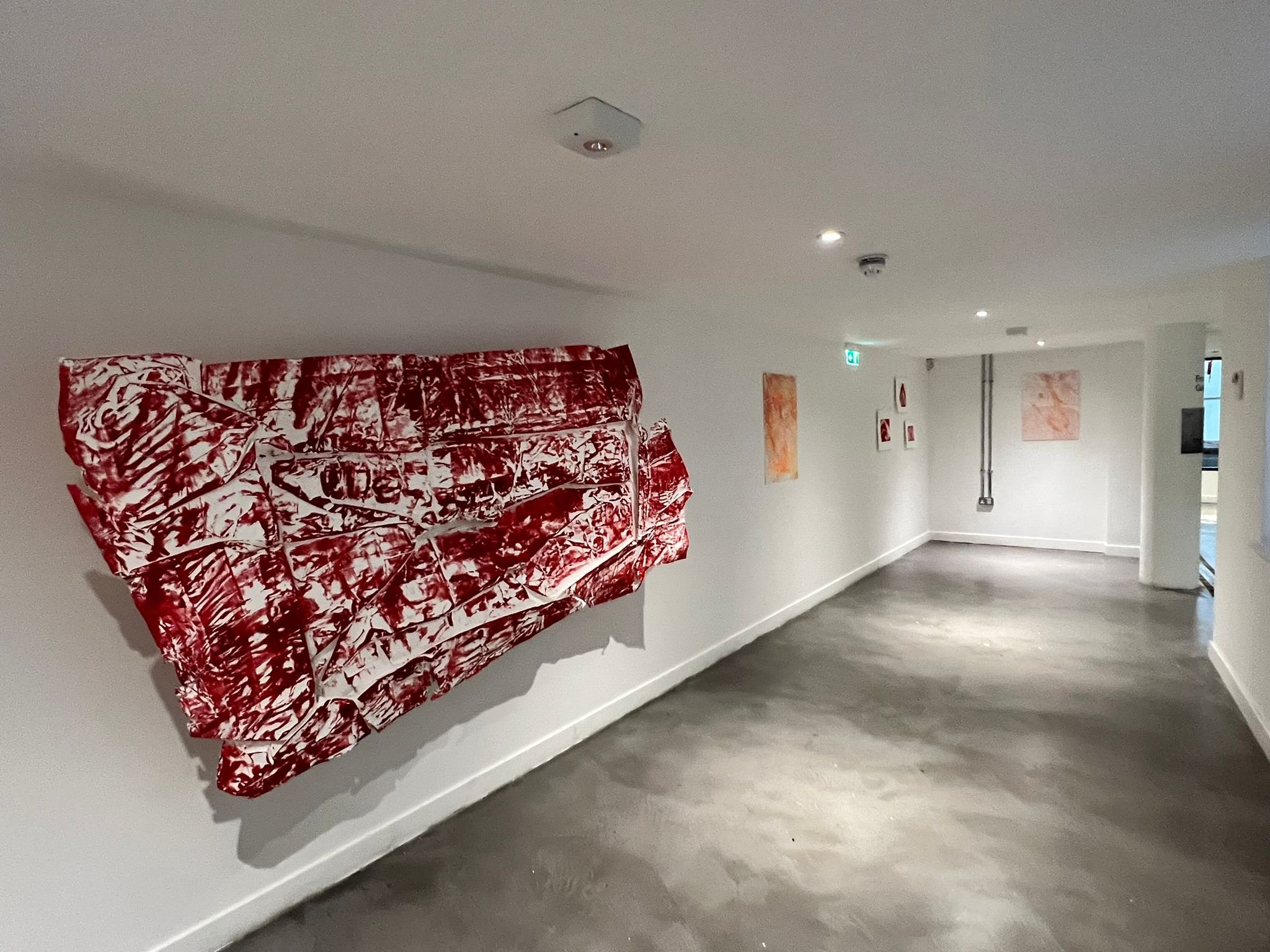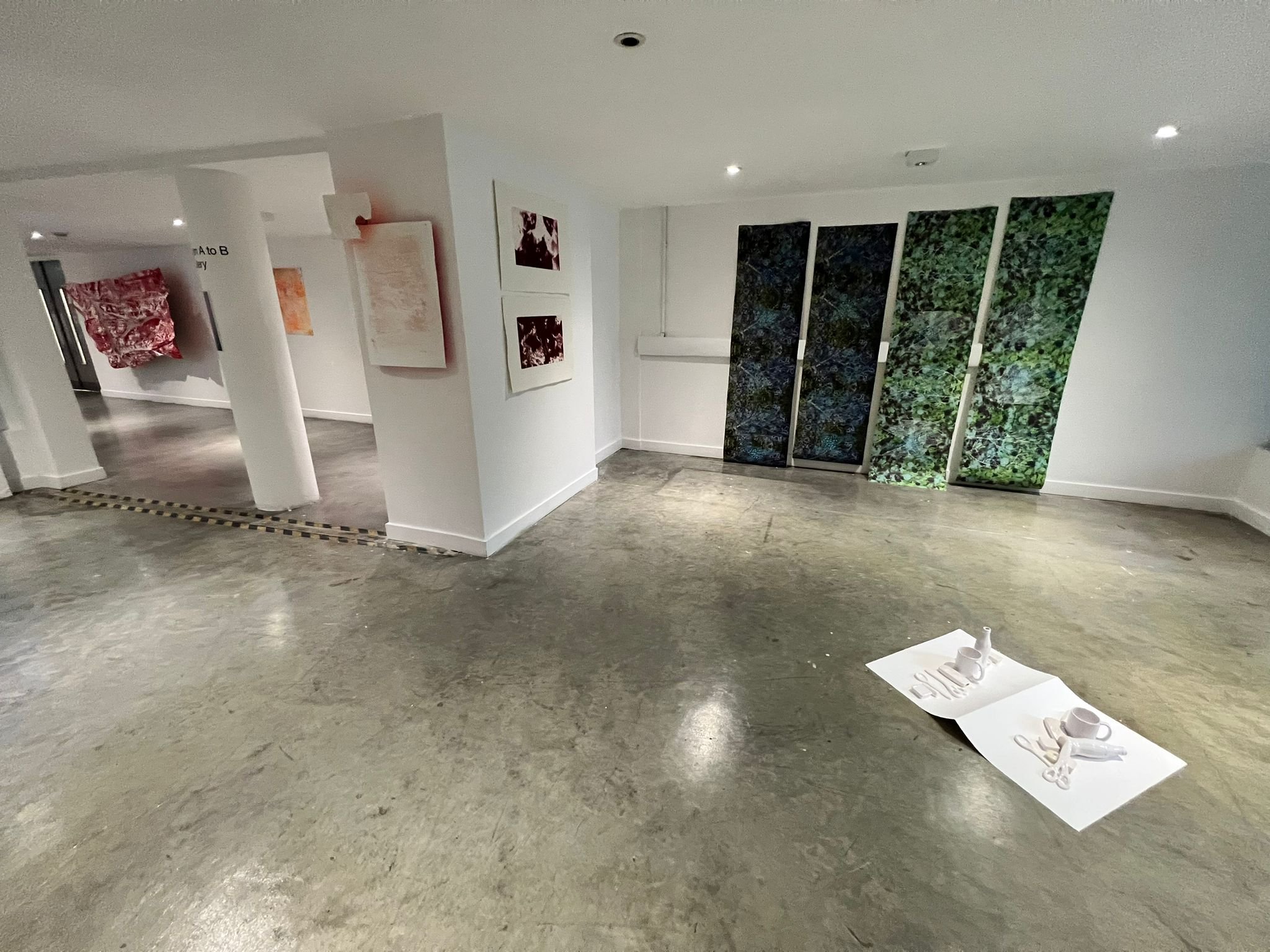Additional Content
Research Festival
Convergence Exhibition
Collaboration Podcast
What Next?
Research Festival
I am intending to share my research in three ways:
- my critical reflection essay which will be posted on the online journal
- a podcast, recording a conversation with Joy Stokes about our collaboration and the parallel evolution of our practice and research
- an artist’s book.
Essay
I chose to produce my critical reflection element as an essay. I find writing a useful way of ordering my thoughts and recording ideas and information – perhaps because of my background in the Civil Service. I wanted to make sure that I reflected on the entirety of the course, to record the journey that my research took me on and the effect that it had on the evolution of my practice. Having done this, I feel that my practice can and should take a new direction – it feels as if it is time to leave the exploration of grief and loss to one side; to take the ideas around memory, containment, temporality and landscape further.
Podcast
Joy and I wanted to explore the connections between our ideas and practices, particularly how their evolution seemed to mirror each other and how effortless the collaborations felt, even though our processes and the concepts we were exploring were apparently quite different. We felt that doing some analysis of what had worked and why would be useful in thinking about our own work and potential future collaborations – with each other and with other artists.
Artis’s Book
My practice during the MA has been around ideas of preservation, protection and small things which evoke or contain vastness. I used a book form for two of my MA Show pieces and book arts tap into my interests in tactility, materiality and folding, so it was probably inevitable that I would make a book for the Research Festival. As with the essay, it feels like an apposite method for synthesising my research and the developments in my practice, but this time in a visual and 3D form.
My intention with the book is to try to encapsulate my ideas about memory, intimate immensity, containment and preservation, navigation and landscape. I have been struggling to envisage the physical form this should take, wanting to have elements of map-folds, containers, images of landscape but in a form that could be portable and pocket-sized. In a tutorial, Leo Brook talked about the aspects of my work that considered the difficulties inherent in trying to protect against the effects of time. This led me to think about trying to present a more sculptural book, but one that could be handled, that might contain or allude to elements previously listed, but referencing the effects of time and use also. So I have been experimenting with visible references to wear and tear and the progression of time; and how to incorporate these into my prints.
Convergence
Carmen van Huistedde on the sculpture pathway asked me to co-curate an exhibition with her. She wanted to do something which celebrated some of the women artists in our MA cohort, their creativity and the support networks and friendships that have grown during the course. She had been inspired by our own friendship, which started on a foundation course at Morley in 2018, and my collaboration with Joy for the MA Show. In a slightly arbitrary way, we invited the group of peers we were having lunch with to take part – I like this sense of happy accident, which is a feature of printmaking, and working with what you have. But I also identified two classmates whose work explore feminist ideas – around landscape and the body; and the hidden history of women’s lives – and asked them to participate. We made this decision on 19th September and Carmen had booked the A-B Gallery for 3 days, starting on 19th October.
The gallery is quite a difficult space: it is literally a corridor, with doors, windows, lifts all opening on to the space and filled with the essentials of the institution: fire extinguishers, fire exit signs, bins, electrical cabling and sockets. In addition, the lighting is limited to overhead spots – and the nature of the space as a corridor means it is not possible to have trailing cables and so on.
But we managed to pull the show together quickly, very much leaving individual artists to submit what work they wanted. It was important to me to have some information about the artists and the works, because the themes in common that did emerge – embodiment, feminism, memory, nature - were important to an understanding of the collection. So we invited participants to provide a few sentences and then were careful to position these notes in ways that didn’t draw attention away from the works.
We had to paint two walls in the space white – three coats to cover up the dark green that had gone up for the degree show in July – and find a way to cover or draw attention away from the bank of power sockets that went right across the middle of one of the major walls. Once this was done, we took only two or three hours to install.
I felt that we had done a good job with a difficult space that imposed real constraints on us. There was a sense of flow from one part of the space to another and I felt that we positioned the works so that they worked together, not in opposition – even though we had some pieces, including mine, that were much quieter and smaller than most. Although the exhibition was fleeting, it did feel celebratory and supportive - I think it might have solidified and strengthened some of the existing relationships: certainly I will be confident of teamwork and success participating in a future exhibition that involves any of this group of artists.
Artists’ Info
press release
exhibition poster
covering up the electrical sockets
installation in progress
first artist installed: Alexandra
installation view
Carmen's 'Blank Canvas'
installation view
Jane's portraits
installation view of Te's work
installation view
'Dialectics of the Skin'
'Fluid Dynamics'
my first untitled piece
my second untitled piece
Collaboration
A discussion with Joy Stokes of the thinking behind our collaborations for the MA Show and Convergence exhibition.
Link here: soundcloud
What Next?
I am feeling quite apprehensive about leaving Camberwell – I did my BA there, starting in 2019 – but I am lucky to have the graduate marketing prize at East London printmakers to look forward to: it has given me a sense of having a bit of space to readjust to life both outside college and in the printmaking community. My intention is to develop a project for the period of the prize, to ensure that I can complete the year with a new body of work – a sort of self-defined residency. I think the project will be about the landscape at Rye Harbour nature reserve – site of the images that I worked on for my large relief prints – and have talked to Aya Kikkaya about the possibility of collaborating on some aspects of this.
I have also talked to Joy Stokes about the possibility of extending our collaboration – potentially to hold a show together of our work, both collaboratively and individually. This course has helped me realise that it suits me to work towards exhibitions, for which I will make specific pieces, alongside a practice that depends on experimentation and learning new processes; so it feels important to make a point of having a series of exhibitions or events scheduled to give me some structure and deadlines.
My first post-MA exhibition is in December at Safehouse 2 in Peckham, with the Second Shift Art Collective; and a few of us from across the MA pathways are intending to develop an exhibition for the New Year as a way of marking the end of the course and our achievements in completing it. I am also talking to printmaking classmates about the possibility of shared studio space, potentially with some printmaking equipment if we can find a source of funding.
Rye Harbour Nature Reserve
Second Shift statement


















